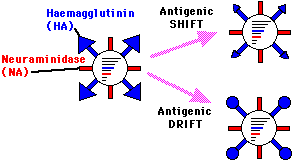Antigenic Drift
Antigenic Drift is a mutation in the genetic code in the
surface antigens. The mutation occurs in the Haemagglutinin (HA)
and Neuraminidase (NA) on the surface of the virus. The changes
in the antigens allow influenza to evade the immune systems of
the host and make a yearly vaccination a necessity. The scientific
nomenclature of influenza comes from the number HA or NA spikes on
the surface of the virus. The influenza occurs in three subtypes:
A, B and C. Type A and B are the most virulent strain and type C
causes mild infections. Type A infects humans, birds and other
mammals, while B and C only infect humans. Type A and B are
responsible for all epidemics, but type A has a greater likelihood.
For example, A(H1N1) would be influenza
type A with one HA spike and one NA spike. Currently, there are
three subtypes circulating, two of which are classified as type A
and one type B.

Another way influenza evades the immune system of the host is
through antigenic shift. Antigenic shift occurs when large
fragments of genetic material are replaced with genes from
other influenza subtypes. It occurs during reassortment, when
the genetic material of the virus is being packed into a new
viron used to infect other cells. Only influenza A can change
by antigenic shift and is responsible for world pandemics and
high mortality rates.
[ Influenza HomePage ] - [ What is Influenza ]
[ History of Influenza ] - [ Replication ]
[ Past Pandemics ] - [ Prevention and Treatment ]
[ Bibliography & Other Links ]
Last modified: 4/24/98


 email: David Zage
email: David Zage